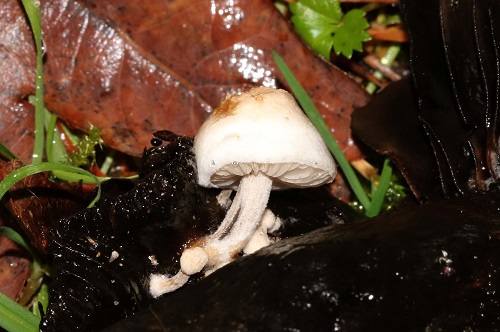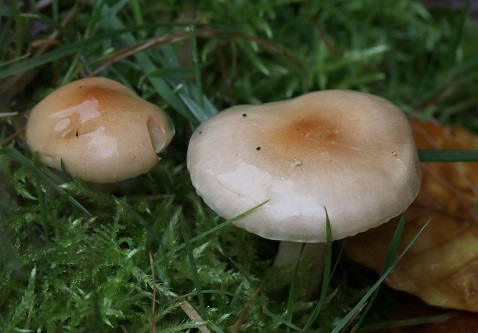Millyford Bridge & Wood Crates
Sat 29 Oct 2022
Field event ID HF2218
OS Grid areas: SU2607 SU2608 SU2708
Report: The mild weather continued to produce the goods for this popular survey destination.
A diminutive, and rare, white dapperling with a stem-ring, Leucocoprinus griseofloccosus, was found near the car-park before we had set off.
Beside the main path, we soon came across a good number of the bonnet, Mycena pseudocorticola and a couple of Bleeding Bonnet (M. sanguinolenta) on Alder. A third white bonnet with scurfy cap and hairy stem found on oak, was Mycena corynephora.
Finds were coming thick and fast with such species as Panther Cap (Amanita pantherina), White Saddle (Helvella crispa), Mealy Oyster (Ossicaulis lignatilis), Upright Coral (Ramaria stricta) and Bark Bonnet (Mycena speirea). Two woodwax species were next up with one being the scarce, Twotone Woodwax (Hygrophorus unicolor) and the other, Ivory Woodwax (Hygrophorus ebernius). An interesting blue-stiped Entoloma species was taken away for examination and later identified as Roughened Pinkgill (E. asprellus).
We soon left the track to continue searching in the deciduous wood where an impressive stand of Golden Scalycap (Pholiota aurivella) was encountered on a fallen Beech. This was soon upstaged by the discovery of Silky Piggyback (Asterophora parasitica) with the fruit-bodies parasitising a rotting Blackening Brittlegill (Russula nigricans).
Just before lunch some very photogenic Orange Oak Bolete (Leccinum aurantiacum) were found with the scarcer, and no less impressive, Gilded Bolete (Aureoboletus gentilis), nearby.
The afternoon finds continued apace, with first a Beeswax Bracket (Ganoderma pfeifferi) and then Jellybaby (Leotia lubrica). Goblet Parachute (Marasmiellus vaillantii), Chanterelle (Cantharellus cibarius), Birch Knight (Tricholoma fulvum), Scurfy Fibrecap (Inocybe petiginosa) and Yellow Swamp Brittlegill (Russula claroflava) were other interesting species recorded.
We then searched a neighbouring pinewood which added Wood Cauliflower (Sparissa crispa), Slippery Jack (Suillus luteus), Violet Webcap (Cortinarius violaceus), Primrose Brittlegill (Russula sardonia), Yellow False Truffle (Rhizopogon luteolus) and the uncommon Sinuous Chanterelle (Pseudocraterllus undulatus).
Finally, we came across another rotting Blackening Brittlegill (Russula nigricans) bearing more piggyback fungi. These were later determined as young fruit-bodies of Powdery Piggyback (Asterophora lycoperdoides), a second species in this genus for the day.
Species recorded: Asterophora lycoperdoides, Asterophora parasitica, Clitopilus hobsonii, Conocybe semiglobata, Crepidotus cesatii, Crepidotus epibryus, Crepidotus variabilis, Entoloma asprellum, Gymnopus inodorus, Gymnopus quercophilus, Hygrophorus eburneus, Hygrophorus eburneus, Incrucipulum ciliare, Lactarius camphoratus, Lactarius semisanguifluus, Lichenomphalia umbellifera, Marasmiellus vaillantii, Mensularia nodulosa, Mycena abramsii, Mycena capillaris, Mycena hiemalis, Mycena olida, Postia subcaesia, Russula, Russula, Russula adusta, Russula aeruginea, Russula anthracina, Russula densifolia, Russula faginea, Russula fragilis var. knauthii, Russula silvestris, Russula velutipes
A full species list with further details can be seen at the Fungal Records Database of Britain and Ireland (FRDBI). Please contact us if you need a user ID.


















